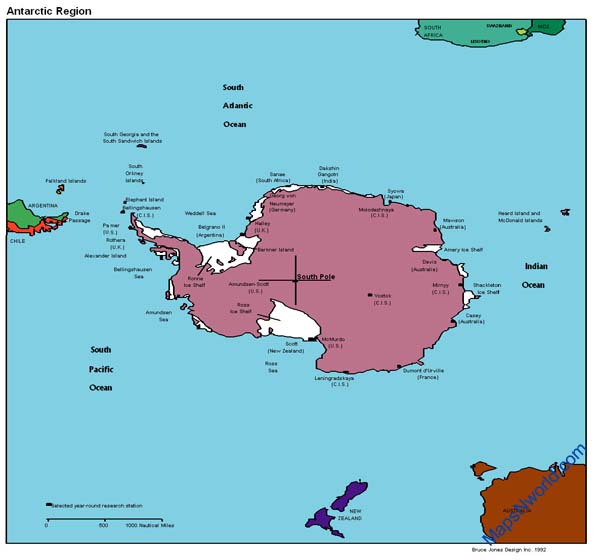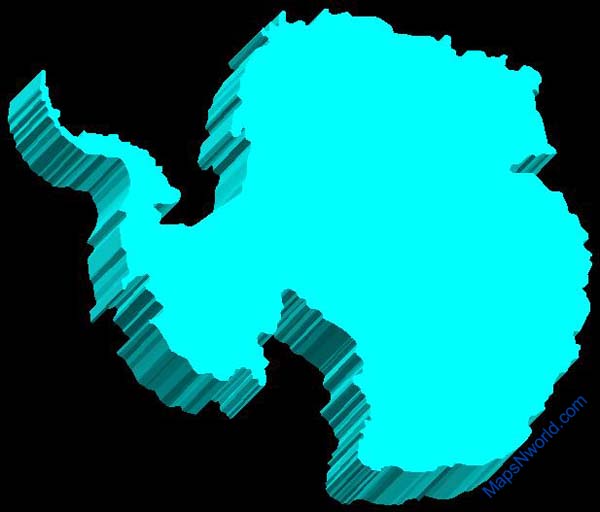
Antarctica | Antarctic region outline map | Antarctic region political map | Where is Antarctica
The South Pole mainly comprises of the coldest continent-The Antarctica. It is the coldest place on Earth, with an average temperature of -50 degree Celsius apprx.
It is said to be wrecked out of Gondwanaland millions of years ago. Antarctica is well known because of the presence of snow on almost all of its landmass. Because of its extreme cold atmosphere, the humans do not inhabit there. Also there isn’t a diverse variety of flora fauna because of the freezing environment. The penguins, blue whale, emperor penguins, sea furs, etc, are few of the species found there. As the resources are inadequate it becomes quite difficult for humans and other species to survive there.
It is interesting to know that according to Allen’s Rule, the appendages, ears, hands, legs, etc, tends to be shorter of animals living in colder region than the ones living in warmer areas so as they radiate a less amount of body heat as compared to animals at warmer places. Antarctica is an immaculate place to visit being exclusive in it. The trip to Antarctica would be overwhelming and an awe-inspiring experience. You’ll be delighted to see the exceptional fauna in its original environment. The mountains, valleys, polar ice caps, etc enthrall you because of its breathtaking beauty. The magnificence of Antarctica, covered all over by ice will leave you mesmerized.
Nowadays because of the great researchers and discoveries there are many things of Antarctica, which has been discovered, but there’s a lot more yet to be revealed.
It’ll be an adventurous tour to visit Antarctica, which is the only continent left intact by humans.
Introduction
Antarctica got its position as a continent in the year 1840. Earlier it was considered as a group of isolated islands. The size of the percent of earth’s land in Antarctica is about 8.9 % and the size of the continent is approximately 13,209,000 sq km, which varies depending on the change in ice shelves. Topography of Antarctica comprises of approximately 98% solid continental ice and just 2% barren rock. There is no existence of life in Antarctica except for the scientists working on the governmental research stations. These stations occupy small group of scientists all through the year. Though there is hardly any scope of tourism in Antarctica, the year 2009-10 saw as many as 37,000 tourists who visited the continent.
Climate of Antarctica
Antarctica is the chilliest place on planet earth with continuous cold wind going on all through the year at a speed of over to 200 miles per hour. Antarctica is also the place where the lowest temperature on earth was recorded and that was – 129.3ºF. winter temperature here varies from -40º to -94ºF.
However, the temperature range within the continent of Antarctica varies depending on height of the place or the distance from the ocean. The entire continent doesn’t possess the same temperature. The east is said to be chillier than the west due to its increased height. On the other hand, Antarctic Peninsula mostly enjoys moderate weather. January sees increase in temperature, which is slight up than below freezing.
Geography
Antarctica is located towards the south of the Antarctic Circle with a geographic coordinates of 90 00 S, 0 00 E. The coastline of Antarctica stretches to 17,968 km. Being a freezing land with coldest wind blowing and dry weather, Antarctica is generally not habitable. Moreover, the continent receives more solar radiation in summer. 98% of Antarctica is solid ice and remaining 2% is barren rock. Normal height from the ground on an average is between 2,000 and 4,000 meters and the mountains are at a height of 5,000 meters.
Natural resources such as copper, iron ore are found in Antarctica. Traces of coal and hydrocarbons, etc., have also been found. But nothing has been used till now. However, commercial fisheries have used fish and crabs.
Economy
The economy of Antarctica is just limited to fishing and on and off tourism. Estimates say that 46,265 visitors visited Antarctic Treaty area in 2007-2008, whereas the number went down to 37,858 in the summer of 2008-09. Almost all such visitors were on commercial ships and yachts.
On the other hand, fishing off the coast also account for the limited economic activity in Antarctica. Three main species were targeted from Antarctica, namely, Patagonian and Antarctic toothfish, mackerel icefish, and krill. However, unregulated fishing is coming up as a serious problem in the continent.
Overview
A treaty called the Antarctic Treaty, signed in 1959 and was enforced in 1961, was formed to give a legal framework for the various actions of different nations taking shape in Antarctica. This treaty doesn’t recognize claims made by seven countries namely, Australia, the United Kingdom, Argentina, Chile, New Zealand, France, and Norway, who made territorial claims on the continent.

Antarctica 3d map
